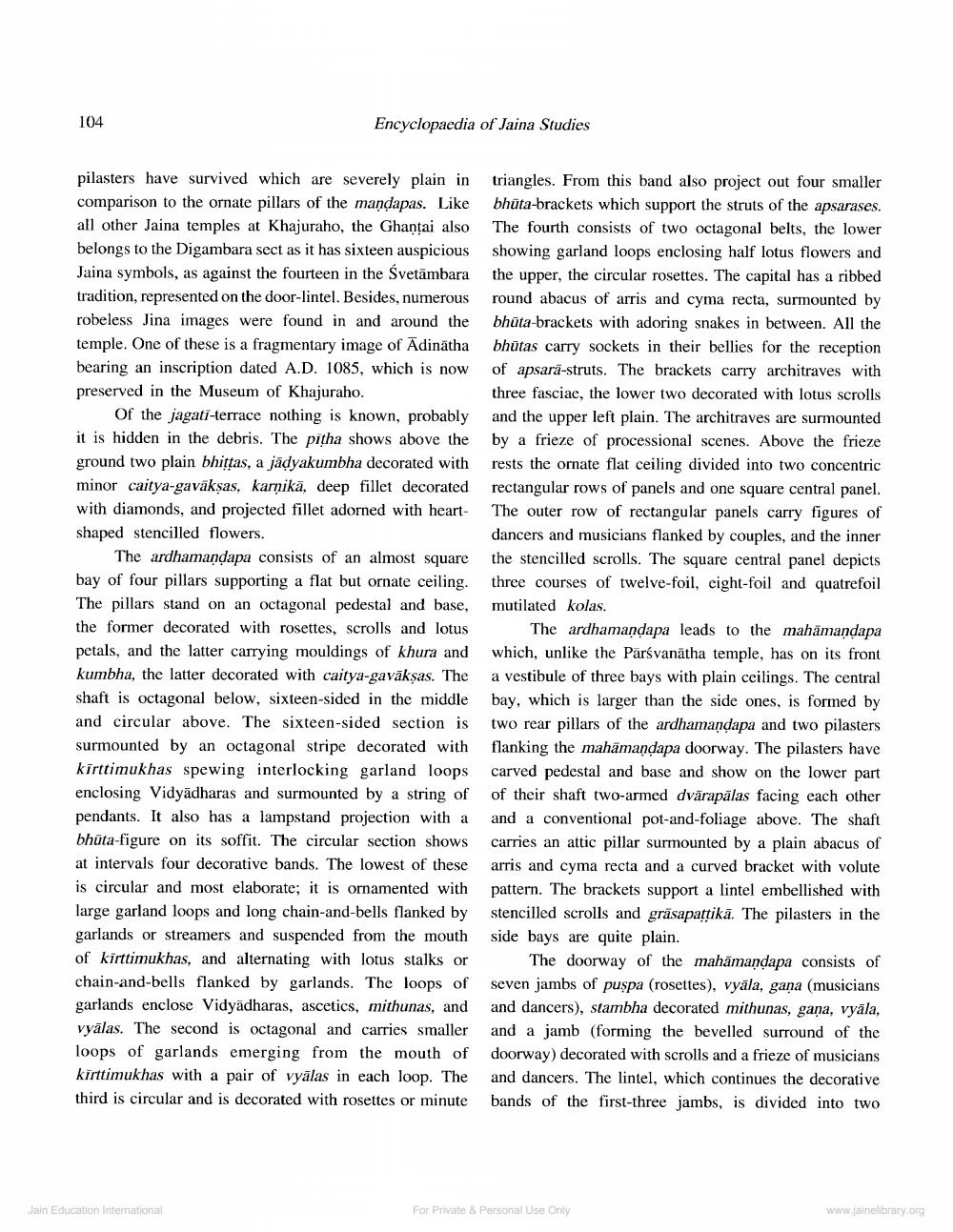________________
104
Encyclopaedia of Jaina Studies
pilasters have survived which are severely plain in comparison to the ornate pillars of the mandapas. Like all other Jaina temples at Khajuraho, the Ghantai also belongs to the Digambara sect as it has sixteen auspicious Jaina symbols, as against the fourteen in the Svetambara tradition, represented on the door-lintel. Besides, numerous robeless Jina images were found in and around the temple. One of these is a fragmentary image of Adinātha bearing an inscription dated A.D. 1085, which is now preserved in the Museum of Khajuraho.
Of the jagati-terrace nothing is known, probably it is hidden in the debris. The pitha shows above the ground two plain bhittas, a jādyakumbha decorated with minor caitya-gavākṣas, karņikā, deep fillet decorated with diamonds, and projected fillet adorned with heart- shaped stencilled flowers.
The ardhamandapa consists of an almost square bay of four pillars supporting a flat but ornate ceiling. The pillars stand on an octagonal pedestal and base, the former decorated with rosettes, scrolls and lotus petals, and the latter carrying mouldings of khura and kumbha, the latter decorated with caitya-gavākṣas. The shaft is octagonal below, sixteen-sided in the middle and circular above. The sixteen-sided section is surmounted by an octagonal stripe decorated with kirttimukhas spewing interlocking garland loops enclosing Vidyadharas and surmounted by a string of pendants. It also has a lampstand projection with a bhuta-figure on its soffit. The circular section shows at intervals four decorative bands. The lowest of these is circular and most elaborate; it is ornamented with large garland loops and long chain-and-bells flanked by garlands or streamers and suspended from the mouth of kirttimukhas, and alternating with lotus stalks or chain-and-bells flanked by garlands. The loops of garlands enclose Vidyadharas, ascetics, mithunas, and vyālas. The second is octagonal and carries smaller loops of garlands emerging from the mouth of kirttimukhas with a pair of vyālas in each loop. The third is circular and is decorated with rosettes or minute
triangles. From this band also project out four smaller bhūta-brackets which support the struts of the apsarases. The fourth consists of two octagonal belts, the lower showing garland loops enclosing half lotus flowers and the upper, the circular rosettes. The capital has a ribbed round abacus of arris and cyma recta, surmounted by bhūta-brackets with adoring snakes in between. All the bhūtas carry sockets in their bellies for the reception of apsara-struts. The brackets carry architraves with three fasciae, the lower two decorated with lotus scrolls and the upper left plain. The architraves are surmounted by a frieze of processional scenes. Above the frieze rests the ornate flat ceiling divided into two concentric rectangular rows of panels and one square central panel. The outer row of rectangular panels carry figures of dancers and musicians flanked by couples, and the inner the stencilled scrolls. The square central panel depicts three courses of twelve-foil, eight-foil and quatrefoil mutilated kolas.
The ardhamandapa leads to the mahamandapa which, unlike the Parśvanātha temple, has on its front a vestibule of three bays with plain ceilings. The central bay, which is larger than the side ones, is formed by two rear pillars of the ardhamandapa and two pilasters flanking the mahāmandapa doorway. The pilasters have carved pedestal and base and show on the lower part of their shaft two-armed dvärapälas facing each other and a conventional pot-and-foliage above. The shaft carries an attic pillar surmounted by a plain abacus of arris and cyma recta and a curved bracket with volute pattern. The brackets support a lintel embellished with stencilled scrolls and grāsapattikā. The pilasters in the side bays are quite plain.
The doorway of the mahamandapa consists of seven jambs of puspa (rosettes), vyāla, gana (musicians and dancers), stambha decorated mithunas, gana, vyāla, and a jamb (forming the bevelled surround of the doorway) decorated with scrolls and a frieze of musicians and dancers. The lintel, which continues the decorative bands of the first-three jambs, is divided into two
Jain Education Intemational
For Private & Personal Use Only
www.jainelibrary.org




